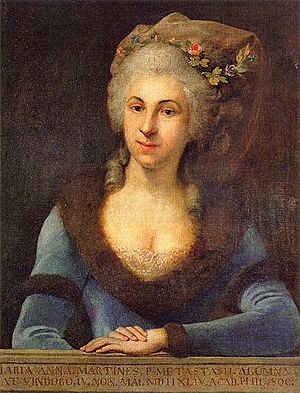Marianna Martines facts for kids
Marianna Martines (born May 4, 1744 – died December 13, 1812) was an amazing composer, pianist, and singer from the Classical music period. She lived in Vienna, Austria, and was friends with famous musicians like Mozart and Haydn.
Contents
Her Family and Early Life
Marianna's grandfather was a Spanish soldier who settled in Italy. Her father, Nicolo Martines, grew up there and later became a "Maestro di Camera" (like a head of household) for the Pope's embassy in Vienna. Because of his service, Marianna's brothers were given a special title in 1774, which is why their family name sometimes includes "von."
When her father was young, he became good friends with a famous poet named Pietro Trapassi, who used the pen name Metastasio. Metastasio became a very important poet for the Austrian Empire. He lived with the Martines family for many years, from about 1734 until he died in 1782. His presence was very important for Marianna's future.
The Martines family lived in a large building in Vienna. In those days, people often lived on different floors based on their social class. The wealthy Esterházy family lived on the lowest floor. The Martines family lived on the third floor. Another resident was Nicola Porpora, a famous Italian singing teacher. At the very top, in a small attic room, lived a young, struggling composer named Joseph Haydn. Marianna's life would soon connect all these people.
Marianna was born in this home in 1744. She was baptized Anna Catherina, but she preferred to be called Marianna.
How Marianna Learned Music
Metastasio, the family friend, helped the Martines children with their education and careers. He noticed Marianna's talent very early on. He made sure she received an excellent education, especially in music.
First, he arranged for her to take keyboard lessons from Joseph Haydn, who lived in the same building. Then, when Marianna was ten, she started singing lessons with Porpora, the famous singing teacher. Haydn even helped out by playing the harpsichord while Porpora taught Marianna.
Soon, Marianna showed a talent for writing music. So, she began more lessons with Johann Adolph Hasse and the Imperial court composer Giuseppe Bonno.
Metastasio also made sure Marianna had a great general education. She spoke Italian and German fluently. She also learned French and even English! This was much more education than most women of her time received.
Marianna's Career as a Performer and Composer
Even as a child, Marianna was good enough to perform for the Imperial court. People were impressed by her beautiful voice and how well she played the keyboard. As an adult, she often performed for Empress Maria Theresa.
Marianna wrote many pieces for a single singer. Experts believe she was often the first person to sing her own works. This shows how talented she was, as her music often had difficult parts that only a very skilled singer could perform.
She wrote many vocal pieces, including two oratorios (large musical works like an opera, but without costumes or staging) and several cantatas (smaller vocal pieces). The words for these pieces were often written by her mentor, Metastasio.
Marianna's surviving works include four masses (music for church services), six motets (choral pieces), and three litanies (prayers). She wrote in the Italian style, which was popular in Vienna during the early Classical period. Her keyboard playing was compared to the style of C.P.E. Bach, another famous composer.
Her music was very well-liked during her time. Some scholars even think that Mozart might have used Marianna's Mass No. 1 as a model for his own Mass in 1768. Her third mass was performed in 1761 at St. Michael's Church, right next door to her home. Her fourth mass was finished in 1765.
Later Life and Legacy
Marianna Martines's name and music were known across Europe. In 1773, she was invited to join the Accademia Filarmonica of Bologna, a very respected music academy in Italy.
Her Italian oratorio, Isacco figura del redentore, was performed in 1782 by a large group of musicians. These concerts also featured works by other famous composers like Haydn, Mozart, Beethoven, and Handel.
Marianna and her sister never married. They took care of their family friend Metastasio until he died in 1782. Metastasio left his money and belongings to the Martines family. Marianna received a large sum of money, his harpsichord, and his music library.
Marianna and her sister often hosted musical gatherings at their home. These weekly events attracted many important guests, including Haydn and the Irish singer Michael Kelly. Mozart was also a frequent guest and would often play piano sonatas (pieces for piano) with Marianna.
Even though she was a very talented performer and composer, Marianna never looked for a paid job as a musician. At that time, it was not considered proper for a woman of her social class to work for money.
Her last known public appearance was on March 23, 1808. She attended a performance of Haydn's oratorio Die Schöpfung, which was conducted by Salieri. This performance was a tribute to Haydn. Marianna Martines died on December 13, 1812, and was buried in St. Marx's Cemetery.
List of Works
Marianna Martines composed:
- 2 oratorios
- 4 masses
- 6 motets
- Psalm cantatas
- Secular cantatas
- 3 keyboard sonatas
- 3 keyboard concertos
- 1 symphony
Several of her pieces have been published recently. Her three keyboard sonatas are available through Hildegard Publishing. Many other works are available through Furore-Verlag, a German publisher that focuses on music by women composers. They offer many first publications, including her Keyboard Concerto in A, Dixit Dominus, In Exitu Israel de Agypto, Laudate Pueri Dominum, and her Fourth Mass.
Images for kids
See also
 In Spanish: Marianne von Martinez para niños
In Spanish: Marianne von Martinez para niños



